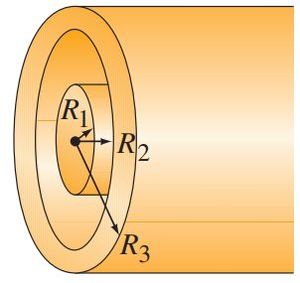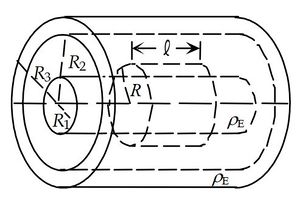Problem
A very long solid nonconducting cylinder of radius  is uniformly charged with a charge density
is uniformly charged with a charge density  . It is surrounded by a concentric cylindrical tube of inner radius
. It is surrounded by a concentric cylindrical tube of inner radius  and outer radius
and outer radius  , and it too carries a uniform charge density
, and it too carries a uniform charge density  Determine the electric field as a function of the distance R from the center of the cylinders for
Determine the electric field as a function of the distance R from the center of the cylinders for
(a) 
(b) 
(c) 
(d) 
plot  as a function of
as a function of  from
from  to
to  cm Assume the cylinders are very long compared to
cm Assume the cylinders are very long compared to  .
.
Solution
The geometry of this problem is similar to the cylinder example in the course (see lecture notes). So we use the same development.

(a)
The charge enclosed in this range is the volume of the inner rod encompassed times the volume charge density

(b)
The only enclosed charge is due to charge of the inner rod.

(c)
The enclosed charge is the total charge of the inner rod, plus the amount enclosed from the outer rod. We can simulate this by considering the outer shell as a positive charge element starting from r=0 and removing the charge due to the cavity by adding a negative charged cylinder up to  . Since we also add the inner cylinder seperately, we end up with charge-no charge-charge setup we intend.
. Since we also add the inner cylinder seperately, we end up with charge-no charge-charge setup we intend.

(d)
All the charge is enclosed. We can recycle the previous result.

(e)



















